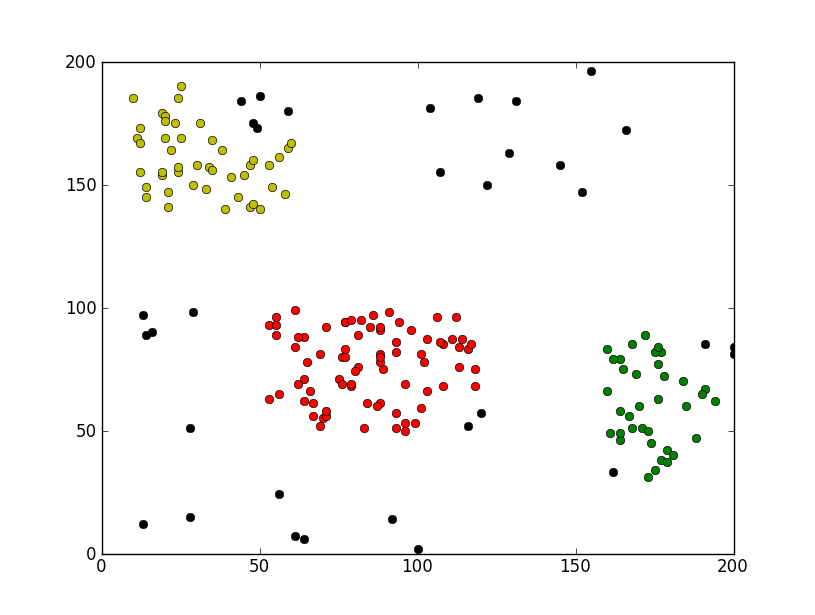Python聚类算法之DBSACN实例分析
本文实例讲述了Python聚类算法之DBSACN。分享给大家供大家参考,具体如下:
DBSCAN:是一种简单的,基于密度的聚类算法。本次实现中,DBSCAN使用了基于中心的方法。在基于中心的方法中,每个数据点的密度通过对以该点为中心以边长为2*EPs的网格(邻域)内的其他数据点的个数来度量。根据数据点的密度分为三类点:
核心点:该点在邻域内的密度超过给定的阀值MinPs。
边界点:该点不是核心点,但是其邻域内包含至少一个核心点。
噪音点:不是核心点,也不是边界点。
有了以上对数据点的划分,聚合可以这样进行:各个核心点与其邻域内的所有核心点放在同一个簇中,把边界点跟其邻域内的某个核心点放在同一个簇中。
# scoding=utf-8
import pylab as pl
from collections import defaultdict,Counter
points = [[int(eachpoint.split("#")[0]), int(eachpoint.split("#")[1])] for eachpoint in open("points","r")]
# 计算每个数据点相邻的数据点,邻域定义为以该点为中心以边长为2*EPs的网格
Eps = 10
surroundPoints = defaultdict(list)
for idx1,point1 in enumerate(points):
for idx2,point2 in enumerate(points):
if (idx1 < idx2):
if(abs(point1[0]-point2[0])<=Eps and abs(point1[1]-point2[1])<=Eps):
surroundPoints[idx1].append(idx2)
surroundPoints[idx2].append(idx1)
# 定义邻域内相邻的数据点的个数大于4的为核心点
MinPts = 5
corePointIdx = [pointIdx for pointIdx,surPointIdxs in surroundPoints.iteritems() if len(surPointIdxs)>=MinPts]
# 邻域内包含某个核心点的非核心点,定义为边界点
borderPointIdx = []
for pointIdx,surPointIdxs in surroundPoints.iteritems():
if (pointIdx not in corePointIdx):
for onesurPointIdx in surPointIdxs:
if onesurPointIdx in corePointIdx:
borderPointIdx.append(pointIdx)
break
# 噪音点既不是边界点也不是核心点
noisePointIdx = [pointIdx for pointIdx in range(len(points)) if pointIdx not in corePointIdx and pointIdx not in borderPointIdx]
corePoint = [points[pointIdx] for pointIdx in corePointIdx]
borderPoint = [points[pointIdx] for pointIdx in borderPointIdx]
noisePoint = [points[pointIdx] for pointIdx in noisePointIdx]
# pl.plot([eachpoint[0] for eachpoint in corePoint], [eachpoint[1] for eachpoint in corePoint], 'or')
# pl.plot([eachpoint[0] for eachpoint in borderPoint], [eachpoint[1] for eachpoint in borderPoint], 'oy')
# pl.plot([eachpoint[0] for eachpoint in noisePoint], [eachpoint[1] for eachpoint in noisePoint], 'ok')
groups = [idx for idx in range(len(points))]
# 各个核心点与其邻域内的所有核心点放在同一个簇中
for pointidx,surroundIdxs in surroundPoints.iteritems():
for oneSurroundIdx in surroundIdxs:
if (pointidx in corePointIdx and oneSurroundIdx in corePointIdx and pointidx < oneSurroundIdx):
for idx in range(len(groups)):
if groups[idx] == groups[oneSurroundIdx]:
groups[idx] = groups[pointidx]
# 边界点跟其邻域内的某个核心点放在同一个簇中
for pointidx,surroundIdxs in surroundPoints.iteritems():
for oneSurroundIdx in surroundIdxs:
if (pointidx in borderPointIdx and oneSurroundIdx in corePointIdx):
groups[pointidx] = groups[oneSurroundIdx]
break
# 取簇规模最大的5个簇
wantGroupNum = 3
finalGroup = Counter(groups).most_common(3)
finalGroup = [onecount[0] for onecount in finalGroup]
group1 = [points[idx] for idx in xrange(len(points)) if groups[idx]==finalGroup[0]]
group2 = [points[idx] for idx in xrange(len(points)) if groups[idx]==finalGroup[1]]
group3 = [points[idx] for idx in xrange(len(points)) if groups[idx]==finalGroup[2]]
pl.plot([eachpoint[0] for eachpoint in group1], [eachpoint[1] for eachpoint in group1], 'or')
pl.plot([eachpoint[0] for eachpoint in group2], [eachpoint[1] for eachpoint in group2], 'oy')
pl.plot([eachpoint[0] for eachpoint in group3], [eachpoint[1] for eachpoint in group3], 'og')
# 打印噪音点,黑色
pl.plot([eachpoint[0] for eachpoint in noisePoint], [eachpoint[1] for eachpoint in noisePoint], 'ok')
pl.show()
运行效果截图如下:

希望本文所述对大家Python程序设计有所帮助。

热AI工具

Undresser.AI Undress
人工智能驱动的应用程序,用于创建逼真的裸体照片

AI Clothes Remover
用于从照片中去除衣服的在线人工智能工具。

Undress AI Tool
免费脱衣服图片

Clothoff.io
AI脱衣机

Video Face Swap
使用我们完全免费的人工智能换脸工具轻松在任何视频中换脸!

热门文章

热工具

记事本++7.3.1
好用且免费的代码编辑器

SublimeText3汉化版
中文版,非常好用

禅工作室 13.0.1
功能强大的PHP集成开发环境

Dreamweaver CS6
视觉化网页开发工具

SublimeText3 Mac版
神级代码编辑软件(SublimeText3)
 PHP和Python:解释了不同的范例
Apr 18, 2025 am 12:26 AM
PHP和Python:解释了不同的范例
Apr 18, 2025 am 12:26 AM
PHP主要是过程式编程,但也支持面向对象编程(OOP);Python支持多种范式,包括OOP、函数式和过程式编程。PHP适合web开发,Python适用于多种应用,如数据分析和机器学习。
 Python vs. JavaScript:学习曲线和易用性
Apr 16, 2025 am 12:12 AM
Python vs. JavaScript:学习曲线和易用性
Apr 16, 2025 am 12:12 AM
Python更适合初学者,学习曲线平缓,语法简洁;JavaScript适合前端开发,学习曲线较陡,语法灵活。1.Python语法直观,适用于数据科学和后端开发。2.JavaScript灵活,广泛用于前端和服务器端编程。
 在PHP和Python之间进行选择:指南
Apr 18, 2025 am 12:24 AM
在PHP和Python之间进行选择:指南
Apr 18, 2025 am 12:24 AM
PHP适合网页开发和快速原型开发,Python适用于数据科学和机器学习。1.PHP用于动态网页开发,语法简单,适合快速开发。2.Python语法简洁,适用于多领域,库生态系统强大。
 vs code 可以在 Windows 8 中运行吗
Apr 15, 2025 pm 07:24 PM
vs code 可以在 Windows 8 中运行吗
Apr 15, 2025 pm 07:24 PM
VS Code可以在Windows 8上运行,但体验可能不佳。首先确保系统已更新到最新补丁,然后下载与系统架构匹配的VS Code安装包,按照提示安装。安装后,注意某些扩展程序可能与Windows 8不兼容,需要寻找替代扩展或在虚拟机中使用更新的Windows系统。安装必要的扩展,检查是否正常工作。尽管VS Code在Windows 8上可行,但建议升级到更新的Windows系统以获得更好的开发体验和安全保障。
 visual studio code 可以用于 python 吗
Apr 15, 2025 pm 08:18 PM
visual studio code 可以用于 python 吗
Apr 15, 2025 pm 08:18 PM
VS Code 可用于编写 Python,并提供许多功能,使其成为开发 Python 应用程序的理想工具。它允许用户:安装 Python 扩展,以获得代码补全、语法高亮和调试等功能。使用调试器逐步跟踪代码,查找和修复错误。集成 Git,进行版本控制。使用代码格式化工具,保持代码一致性。使用 Linting 工具,提前发现潜在问题。
 PHP和Python:深入了解他们的历史
Apr 18, 2025 am 12:25 AM
PHP和Python:深入了解他们的历史
Apr 18, 2025 am 12:25 AM
PHP起源于1994年,由RasmusLerdorf开发,最初用于跟踪网站访问者,逐渐演变为服务器端脚本语言,广泛应用于网页开发。Python由GuidovanRossum于1980年代末开发,1991年首次发布,强调代码可读性和简洁性,适用于科学计算、数据分析等领域。
 vscode怎么在终端运行程序
Apr 15, 2025 pm 06:42 PM
vscode怎么在终端运行程序
Apr 15, 2025 pm 06:42 PM
在 VS Code 中,可以通过以下步骤在终端运行程序:准备代码和打开集成终端确保代码目录与终端工作目录一致根据编程语言选择运行命令(如 Python 的 python your_file_name.py)检查是否成功运行并解决错误利用调试器提升调试效率
 vscode 扩展是否是恶意的
Apr 15, 2025 pm 07:57 PM
vscode 扩展是否是恶意的
Apr 15, 2025 pm 07:57 PM
VS Code 扩展存在恶意风险,例如隐藏恶意代码、利用漏洞、伪装成合法扩展。识别恶意扩展的方法包括:检查发布者、阅读评论、检查代码、谨慎安装。安全措施还包括:安全意识、良好习惯、定期更新和杀毒软件。






